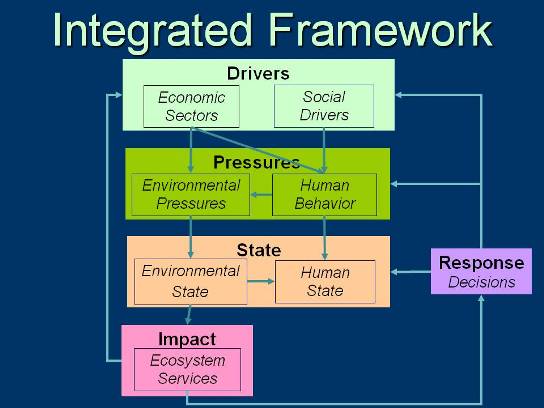Tutorials on Systems Thinking
Integrated Framework: State

7 / 26
Human activities create Pressures on the State of abiotic (physical & chemical) and biological (humans and other biota) components of the ecosystem. The condition of the built and natural environment, as well as human behaviors, can influence human exposure and effects on human health.
Environmental State - the condition of the physical, chemical, and biotic environment in which humans live, depend, or may be affected by
- Abiotic state - the magnitude, frequency, and concentration of abiotic components of the environment. The abiotic environment influences the survival, growth, and distribution of living organisms in the Biological state.
- Physical & chemical environment - includes Physical variables such as climate, air and sea temperature, precipitation, storms & hurricanes, drought, hydrology, ocean circulation patterns, or fire, and Chemical variables such as nutrients, pH, atmospheric CO2 levels, salinity, or contaminants in air, water, soil, or food.
- Built environment - man-made physical structures or extreme modifications of the natural environment, including buildings, roadways, household furnishings, landfills, brownfields, or parks, and their pattern of distribution or density within the human habitat.
- Biota - the biological components of the ecosystem and their interactions. In general, this includes plants or animals that provide the living habitat and base of the food web that supports higher trophic levels. Biological condition may be measured by individual- or community-level attributes.
- Living habitat - sessile plants and animals that compete for space, light, and nutrients within the physical habitat, and generally form the basis of the food web as primary producers. Examples include deserts, wetlands, grasslands, forests, coral reefs, and agricultural lands.
- Inhabitants - the biota, typically animals, associated with and dependent on living habitat for resources & shelter including birds, mammals, fish, reptiles, amphibians, and invertebrates.
- Invasive species - compete with, prey upon, or alter interactions among native species. They may enter the system through intentional introductions, hitchhiking on human transportation (cars, boats) or other animals, or accidental release of pets, garden plants, or aquarium species. Invasive species terrestrial animals and plants, or aquatic species.
- Microorganisms and pathogens - may have benefits in ecosystem function, such as decomposers or mycorrhizae, or be disease-causing agents, and include bacteria, fungi, and viruses.
Human State - the condition of individuals or community-level attributes of the human population
- Individuals - measurable attributes of individuals that reflect impacts of environmental degradation or personal behavior
- Personal characteristics - aspects of the individual person that contribute to vulnerability including age, gender, or ethnicity
- Body Systems - the condition (healthy or diseased) of key human body systems, derived from the MERCK Manual, including respiratory, immune, gastrointestinal, reproductive, endocrine, and neurological systems, mental health, and genetics
- Communities - the characteristics of the community in which humans live, including the population size or density, ethnic diversity, socio-economic status
